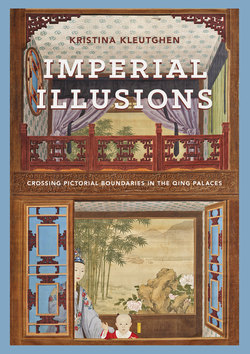Читать книгу Imperial Illusions - Kristina Kleutghen - Страница 41
На сайте Литреса книга снята с продажи.
Оглавлениеfrom a diverse pantheon.22 Far larger than life-size, whether Buddhist or Daoist, these meticulously detailed and colorful works overwhelm the viewer and occupy his or her entire visual field, while some figures within their dense assemblages often engage the viewer directly from inside the painting to increase the perception of a real vision and experience of the divine. Although tomb murals eventually disappeared entirely, through the Ming and Qing dynasties temple murals continued to employ this basic combination of size, realistic detail, wall surface, and overall illusionistic presentation to create an intense visual experience.23
Despite the persistence of illusionistic murals in the Chinese cultural landscape, from very early on there was a disjunction between their popular presence and elite aesthetic responses to them. Some argue that three-dimensional modeling through tone and shading is an indigenous technique that had been part of Chinese painting since the Han dynasty; even if true, at best it was much less well developed than other qualities in painting because it was already considered to be of lesser importance even at this early stage of theorization.24 The slow rise of the highly educated literati (wenren) class as the social and political elite and arbiters of aesthetic taste coincided with the growing production of portable painting formats and critical valorization of a self-consciously amateurish and deliberately abstracted style of ink painting. Admittedly, this characterization is somewhat artificial and essentializing, and recent research has demonstrated how far the reality of literati-style painting could be from its ideologies and hagiographies.25 Nevertheless, the literati painting ideal prioritized self-expression over naturalism with an established lexicon of brushwork derived from calligraphy and a limited range of subjects (most notably landscape) represented in ink and perhaps light organic colors. The literati amateur painter sought to achieve “spirit resonance” (qiyun) in his painting, and belittled the spectacularly realistic but technical “formlikeness” (xingsi or xiangxing) used by trained professional painters (such as muralists) to appeal to the uncultured public. Painting theorist Xie He (act. c. 500) codified the preeminence of spirit resonance in his Six Laws of painting, which listed this indefinable quality as the most important, followed closely by brushwork. Formlikeness was third, barely above the mundane elements of color, composition, and copying. However complicated this polarization of brushwork and expression against detail and realism has been proven to be, Xie He’s laws had a profound effect on later centuries of discourse on pictorial illusionism.
Already during Xie He’s time, some early literati deemed illusionistic murals the worst of all paintings for their reliance on formlikeness, manipulated to an extreme by professional painters, and criticized muralists as merely wall painters—artisans rather than artists. The highest praise an early muralist other than Wu Daozi could generally hope to receive was what Xie He himself granted to the temple muralists Qu Daomin and Zhang Jibo (both later fifth century), noting that their skill in architectural painting “penetrated to the divine.”26 Even the highly respected muralist Zhang Sengyou (act. late fifth to mid- sixth centuries), of whom Wu Daozi was believed to be the reincarnation,27 only “strode
